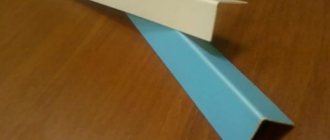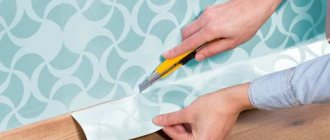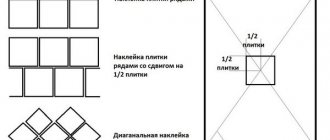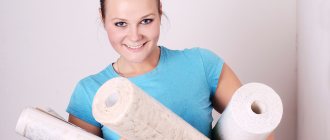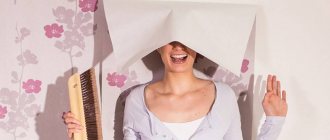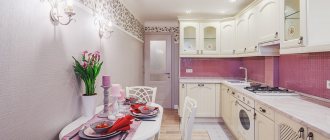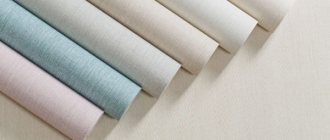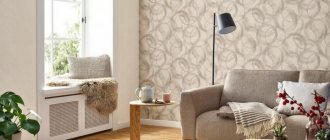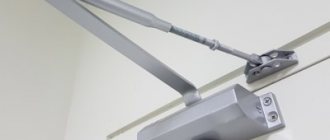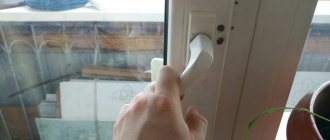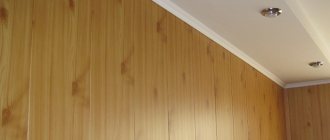Savig
9515 0 6
Savig October 26, 2017Specialization: master of interior finishing works. I am well versed in power tools for repair and construction. Formerly a teacher at a radio engineering college.
With the right approach, when combining panels with wallpaper, you can get an excellent result
Is it possible to glue wallpaper on PVC or MDF panels? In search of answers to this question, I propose to consider the features and instructions for combining these finishing materials. Visual illustrations will help you understand everything.
Is it possible to glue wallpaper on MDF panels?
Sometimes, due to the characteristics of the premises, during interior decoration we are forced to resort to the use of several types of finishing materials at once. This method allows you to focus on the obvious advantages of the interior, hiding some of the disadvantages of the room itself or each of the finishing materials. Today, one of the most popular options is a combination of wallpaper and various panels - PVC, MDF, SIP and others. While some people are just wondering whether it is possible to glue wallpaper on MDF panels, this method of decorating the interior has already proven itself to be effective in both living rooms and non-residential premises. Let's look at this technology in detail.
Video material
Now you can significantly expand and vary your fantasies regarding the interior design of any room, because now you understand whether it is possible to glue wallpaper on MDF panels and any other panels, how they can be profitably combined. Successful creative tests for you in the struggle for the comfort of your own home!
How to glue wallpaper on panels?
Construction hypermarkets and finishing materials markets sell a wide range of different types of decorative panels for finishing walls and ceilings. We will look at the most popular of them, and also answer the question of whether it is possible to glue wallpaper on MDF and similar materials, and how to do it correctly.
PVC wallpaper and trim
Before you start gluing wallpaper in combination with plastic panels, you need to prepare the work surface. Your flow of action should look something like this:
- Prepare all the necessary tools and materials - primer for plastic panels, solvent, sandpaper or its equivalent with fine grain.
- Sand the glossy surface, making it matte where the panel and wallpaper are attached (for better fixation).
- Wipe off any fine dust from the surface of the plastic with a slightly damp cloth and wait until it dries completely.
- Apply a primer that is designed specifically for use on plastic trim.
- Treat the surface using special tools with an adhesive primer with the addition of a solvent.
Surface preparation is complete. Now you can start gluing wallpaper, no longer wondering whether it is possible to glue wallpaper on plastic panels, because the answer will be positive: yes, it is possible!
Panels made from wood products
In many large construction stores you can easily purchase analogues of decorative panels made from woodworking products. They contain ground coniferous wood. Small particles are bonded together by pressing at high temperatures. Thus, MDF panels do not contain “chemicals” such as resin, glue, etc.
Important! Such panels have good heat and sound insulation properties. As a rule, the width of the MDF panel is 58-60 cm, height - 2.5-2.7 m, thickness - 12 mm. Today on sale you can find a wide selection of MDF panels of various colors and textures.
Modern production technology creates light and porous boards with good density, which makes it possible to glue wallpaper or even textiles onto similar MDF panels. In this case, any type of wallpaper can be used - paper, vinyl, fiberglass and others. That is, to the question whether it is possible to glue wallpaper on MDF, the answer will be positive, but under a mandatory condition: the panels must be well primed with a special compound so that they do not absorb all the glue.
Liquid wallpaper and SIP panels
A popular type of finishing today is a combination of SIP panels and liquid wallpaper.
Installation of the latter on decorative surfaces, including SIP panels, is quite simple. However, when using liquid wallpaper in a room with high humidity, it should be additionally treated with a protective layer of a special coating.
In general, liquid wallpaper is a good option for interior decoration. They have excellent performance characteristics, and at the same time have a beautiful appearance thanks to the various inclusions included in the composition. Plus - they are quite easy to install, which even a non-professional can handle, following the instructions.
Preparatory process
Before the preparatory stage, wallpaper is purchased, and then, based on its quality, tools and materials are prepared:
- Glue selected specifically for this type of material and a container for it.
- Brush or paint brush for applying glue.
- Roller for smoothing fabrics.
- Scissors, ruler, pencil, rag.
For wood-based panels, it is better to purchase vinyl, non-woven materials or silk-screen printing. It is these types that will hide unevenness and some deformations of the slabs in the future.
Plane preparation process:
- Treat the chipboard and seal the heads of nails, self-tapping screws and screws with putty.
- Putty the uneven surfaces of the planes with a special mixture for wood.
- Process and seal openings using special meshes.
- If there are old paintings hanging on the walls, then they must be dismantled.
If the old materials are firmly glued, then do not clean them, but coat them with a layer of adhesive solution.
- Prime the entire surface in two layers.
Preparation for priming:
- Thoroughly clean the surface from dust using a vacuum cleaner and damp rags.
- If there are any roughness, then go over it with fine sandpaper.
- Clean the plane again.
Priming is carried out before and after puttying. Each subsequent layer of primer is applied perpendicular to the previous one.
How to combine materials correctly?
There are a huge number of options for combining different finishing materials. Let's look at the features of using the most popular of them when decorating small apartments or country houses.
Geometric combination of finishes
The design of surfaces with alternating vertical or horizontal inserts of wallpaper and panels is suitable for absolutely any room design:
- Fragments can be highlighted by alternating different panels and wallpapers for decoration. The most suitable for this option would be thick vinyl or non-woven wallpaper with relief.
- Stripes can be alternated in different colors - contrasting or solid shades.
- The width of the strips that is optimal for the room should be selected based on the height of the ceiling or the length of the wall.
- The decoration of the corridor and other rooms can clearly demarcate each other with borders, friezes, and moldings. Such material will not only disguise the joints, but also serve as a decorative element.
Application of inserts:
- The first step is to prepare the walls, prime them with a special solution.
- The surface is then wallpapered or paneled.
- Next, the necessary finishing is installed in pre-designated areas.
Important! Inserts can be strips of wallpaper or sections of panels of different shapes and sizes. This method involves decorating some elements with borders or moldings.
Wallpaper inserts over a large area
This method is necessary for finishing different semantic areas in one room, that is, for its zoning. For example:
- When dividing a children's room into a bedroom, play area and study area, you can install panels of calm colors in the area of the bed and desk, and apply brightly colored canvases for the play area.
- For a living room, a good option is to use contrasting panels or wallpaper to highlight a niche with a TV installed.
- In the bedroom, the most commonly used option is to highlight the head of the bed. The best option is a combination of wallpaper and panels that have different shades of the same color.
Application of flaps
This original method of combining finishes is suitable for creating an unusual room design. Here everything is limited only by the imagination of the master. Wallpaper is cut into pieces of various shapes and sizes. Then they are glued to the surface in any order, creating beautiful patterns.
Important! Do not forget about pre-treatment of the panels before applying wallpaper to them.
Non-standard room geometry - what to do?
If the room has a complex configuration with the presence of ledges and niches, do not be upset and consider this fact a disadvantage of the house. It is easy to make such a design an advantage, and you don’t have to spend a lot on such changes. To do this, you simply need to highlight all non-standard areas from the general space of the house by combining different finishing materials. Having played with the complex shape of the room in this way, your eyes will see a completely different view of it.
Development of gluing of rolled products
You can only wallpaper wood panels with your own hands. In order for all procedures to be carried out correctly, you need to be careful and sequence the actions.
Materials and tools
The following materials and equipment will be useful for gluing work:
- Primer. You need to choose a composition with the deepest penetration. The best option is polymer consistency. You can also use “concrete contact”.
To treat the base, only deep-penetrating soil is used.
- Wallpaper. The variety is selected based on the wishes and style of the room. You should avoid single-layer cardboard products.
- Glue. For each type of material there is a special composition.
- Putty. It is recommended to obtain putty for chipboard on an acrylic or oil base, which has elasticity. This is especially important for recently built houses. Ready-made mixtures are desirable.
The putty must be created for wood or wood materials - Serpyanka mesh. Will be needed to reinforce slab joints.
- Brushes and roller. To apply primer and glue, a number of types and replaceable nozzles should be provided.
- Set of spatulas. You will need a small, medium and wide tool.
- Containers for mixing mixtures.
- Devices for smoothing wallpaper.
Small set of tools for puttying wallsEverything you need is purchased in advance. If used tools are used, they are previously cleaned of previous materials.
Surface preparation
The labeling of rolled products on different panels may vary slightly, so you need to proceed from a specific situation. Preparatory work includes a number of procedures specific to each species:
- Chipboard. This base needs sanding. The fact is that the upper structure is not always uniform, particles can flake off. So that they do not interfere with work in the future, they are removed with sandpaper.
Fiberboard. Wallpapering fibreboards is much more difficult. This is explained by the fact that the front side of the hardboard is impregnated with a paraffin-based composition to increase water resistance. When gluing decorative products, this makes it difficult, so the slabs are processed with a grinding machine, sparingly removing a very narrow layer.
- Chipboard. The laminated coating also makes adhesion difficult, so this surface is painstakingly sanded - as in the previous version - until a rough base is obtained.
- MDF. To hang wallpaper on an MDF panel, you will need to perform similar procedures, but be careful: the surface only needs light sanding.
All wood-based materials must be sanded before finishing.
General preliminary processes after completion of preparatory work:
Padding. The surface is covered with a roller with 2 layers of the composition, each one is dried.
The primer is applied with a brush or roller. Sealing of joints. When working with fiber boards, the edges of adjacent ends are cut at an angle with a construction knife. Chipboard walls are not subject to jointing. Then the seams are filled, the excess is removed.
The seams and fastening screws are puttied first. Laying serpyanka. It covers the front and corner joints (there is a special variety); a narrow layer of consistency is applied on top, completely covering the reinforcing mesh.
Serpyanka fiberglass mesh significantly increases the level of adhesion to the putty surface. The base should be puttyed as follows: the solution is scooped onto the blade of a wide spatula and distributed over the surface using arcuate movements from top to bottom. The function is repeated, after which the coating is primed.
The putty dries for at least 2 – 3 days
The walls are left until completely dry.
On a note! If the vertical system has a deviation, then it is first recommended to plaster the surface, after which lay the final layer of putty.
Pasting
Work begins with assessing the adhesion of the putty; for this, the surface is lightly tapped. If there are no delaminations, proceed to the process:
Wallpaper pasting tool
- The space for work is prepared in advance and all excess is removed. Wallpaper should be cut taking into account the fit of the pattern.
- It is recommended to start gluing from the window opening. The first strip is painstakingly measured, since other fragments are oriented towards it.
- Glue is applied sparingly to the underside of the wallpaper, after which the canvas is folded in half. This will avoid drying out and ensure the appropriate level of impregnation. If required, the wall is also treated with the substance.
- The strip is laid in its space, adjusted from above and pressed. For smoothing, use a rag or rubber spatula.
- Other elements are glued in a similar way.
The method of wallpapering does not change depending on the type of base
There is a recommendation that surfaces should be varnished. Indeed, this can be created, but achieving the desired decorative effect will be difficult. In addition, the front layer will become the most languid, which can lead to detachment.
Need to know! If the strips are connected end-to-end, then purposefully attach a special intermediate tape.
Can you please tell me if MDF can be covered with wallpaper?
Glue on thick PVA. For best quality, iron with an iron (through newspaper). After drying, you can coat it with varnish, preferably PF. You can also use self-adhesive.
It is possible, of course, and not only with wallpaper, but with anything you want, you can even stick old newspapers there - creative and unusual, but what savings during a crisis.
Of course, only MDF quickly absorbs glue, so you need to do everything quickly. This is if flaseline, that is, wide, one meter long. If the usual ones are half a hundred centimeters long, then there’s no need to rush. Anyway, you need to smear the wallpaper so that it absorbs the glue and water and at the last moment and MDF. In this case, it is advisable, after gluing the panel, to tear off the edges along the entire length from top to bottom and glue, or rather coat them with Korean PVA glue. And then put the edges back in place and use a wallpaper roller, such plastic plastic, white, although there are black ones. Width roll along the edges five centimeters to remove excess glue in this place and it will become thinner under the paper and therefore after three to four hours it will stick in this place. And the rest of the mass will dry more slowly and when the wallpaper begins to shorten during drying, the edges will be glued they won’t let you sit down and there won’t be the smallest strip of gap between the panels. Just don’t try to roll them with a wide roller like they used to roll and polish photographs, like in the “Repair School” show. This is for suckers. This girl is stupid and doesn’t understand anything about wallpaper. And the panel wallpaper should only be smoothed with a special brush like this, a German one sold everywhere. The handle is wooden with a hole in the side. There is no better brush in the world. The bristles are white. It’s better to buy two at once. Remove excess glue with a damp cloth. With this narrow wallpaper roller you can remove excess wallpaper on top of each other We went in to spread it, rolling it with pressure, and if it’s not enough and you get a gap, then also stretch the panel with pressure and seal it. I’ve had both the walls and the ceiling glued like this for 15 years now and there’s not a single crack. And if there weren’t Korean PVA, then the edges would have long ago bounced off. And my wife says that the wallpaper is still like new. Just don’t take cheap wallpaper. They will lose their appearance faster. The larger the texture, that is, the thickness of the pattern, take it. And so that the wallpaper does not shine under any circumstances. At the slightest hole or a grain of sand will have shadows on the entire wall. And as usual, don’t glue everything up to the ceiling. It’s the illiterate suckers who do that. Don’t add 10-20 centimeters to the ceiling. If the ceiling is whitened with water emulsion, then whitewash this part of the wall too. Then cut the wallpaper evenly and Glue a contrasting edging frieze or border around the entire perimeter. In this case, the ceiling is not cut off and the room appears visually higher. And no foam frieze is needed in the corners. And if the ceiling is also covered in wallpaper, then this part of the wall will also be covered with ceiling and edging. It will be beautiful .All unevenness in the corners will disappear and it will appear visually even. The wallpaper must be trimmed at all internal corners. Do not sag under any circumstances. Leave one centimeter for the fold. Then this fold will be hidden with a new panel. And do not glue to the bottom either. ONLY to the window sill .The bottom panel is covered with other wallpaper and a connecting border. Then it’s easier to do the repairs. Several years have passed, only the wall was changed. Then the bottom panel. Don’t even think about gluing PVA, as some advise, only fools do that. Ordinary wallpaper glue or something else. There are colored ones blue or red glue. Any wallpaper can be glued to either glass or iron, plywood, etc. As a last resort, coat it with liquid PVA and water in advance and apply glue the next day. I told you how to glue it to anything at all.
Development of gluing of rolled products
You can only wallpaper wood panels with your own hands. In order for all procedures to be carried out correctly, you need to be careful and sequence the actions.
Materials and tools
The following materials and equipment will be useful for gluing work:
- Primer. You need to choose a composition with the deepest penetration. The best option is polymer consistency. You can also use “concrete contact”.
To treat the base, only deep-penetrating soil is used.
It is recommended to obtain putty for chipboard on an acrylic or oil base, which has elasticity. This is especially important for recently built houses. Ready-made mixtures are desirable. The putty must be created for wood or wood materials
Small set of tools for puttying walls
Everything you need is purchased in advance. If used tools are used, they are previously cleaned of previous materials.
Surface preparation
The labeling of rolled products on different panels may vary slightly, so you need to proceed from a specific situation. Preparatory work includes a number of procedures specific to each species:
- Chipboard. This base needs sanding. The fact is that the upper structure is not always uniform, particles can flake off. So that they do not interfere with work in the future, they are removed with sandpaper.
Fiberboard. Wallpapering fibreboards is much more difficult. This is explained by the fact that the front side of the hardboard is impregnated with a paraffin-based composition to increase water resistance. When gluing decorative products, this makes it difficult, so the slabs are processed with a grinding machine, sparingly removing a very narrow layer.
All wood-based materials must be sanded before finishing.
General preliminary processes after completion of preparatory work:
- Padding. The surface is covered with a roller with 2 layers of the composition, each one is dried.
The primer is applied with a brush or roller. Sealing of joints. When working with fiber boards, the edges of adjacent ends are cut at an angle with a construction knife. Chipboard walls are not subject to jointing. Then the seams are filled, the excess is removed.
The seams and fastening screws are puttied first. Laying serpyanka. It covers the front and corner joints (there is a special variety); a narrow layer of consistency is applied on top, completely covering the reinforcing mesh.
Serpyanka fiberglass mesh significantly increases the level of adhesion to the putty surface. The base should be puttyed as follows: the solution is scooped onto the blade of a wide spatula and distributed over the surface using arcuate movements from top to bottom. The function is repeated, after which the coating is primed.
The putty dries for at least 2 – 3 days
The walls are left until completely dry.
On a note! If the vertical system has a deviation, then it is first recommended to plaster the surface, after which lay the final layer of putty.
Pasting
Work begins with assessing the adhesion of the putty; for this, the surface is lightly tapped. If there are no delaminations, proceed to the process:
Wallpaper pasting tool
- The space for work is prepared in advance and all excess is removed. Wallpaper should be cut taking into account the fit of the pattern.
- It is recommended to start gluing from the window opening. The first strip is painstakingly measured, since other fragments are oriented towards it.
- Glue is applied sparingly to the underside of the wallpaper, after which the canvas is folded in half. This will avoid drying out and ensure the appropriate level of impregnation. If required, the wall is also treated with the substance.
- The strip is laid in its space, adjusted from above and pressed. For smoothing, use a rag or rubber spatula.
- Other elements are glued in a similar way.
The method of wallpapering does not change depending on the type of base
There is a recommendation that surfaces should be varnished. Indeed, this can be created, but achieving the desired decorative effect will be difficult. In addition, the front layer will become the most languid, which can lead to detachment.
Need to know! If the strips are connected end-to-end, then purposefully attach a special intermediate tape.
Can you please tell me if MDF can be covered with wallpaper?
Glue on thick PVA. For best quality, iron with an iron (through newspaper). After drying, you can coat it with varnish, preferably PF. You can also use self-adhesive.
It is possible, of course, and not only with wallpaper, but with anything you want, you can even stick old newspapers there - creative and unusual, but what savings during a crisis.
Of course, only MDF quickly absorbs glue, so you need to do everything quickly. This is if flaseline, that is, wide, one meter long. If the usual ones are half a hundred centimeters long, then there’s no need to rush. Anyway, you need to smear the wallpaper so that it absorbs the glue and water and at the last moment and MDF. In this case, it is advisable, after gluing the panel, to tear off the edges along the entire length from top to bottom and glue, or rather coat them with Korean PVA glue. And then put the edges back in place and use a wallpaper roller, such plastic plastic, white, although there are black ones. Width roll along the edges five centimeters to remove excess glue in this place and it will become thinner under the paper and therefore after three to four hours it will stick in this place. And the rest of the mass will dry more slowly and when the wallpaper begins to shorten during drying, the edges will be glued they won’t let you sit down and there won’t be the smallest strip of gap between the panels. Just don’t try to roll them with a wide roller like they used to roll and polish photographs, like in the “Repair School” show. This is for suckers. This girl is stupid and doesn’t understand anything about wallpaper. And the panel wallpaper should only be smoothed with a special brush like this, a German one sold everywhere. The handle is wooden with a hole in the side. There is no better brush in the world. The bristles are white. It’s better to buy two at once. Remove excess glue with a damp cloth. With this narrow wallpaper roller you can remove excess wallpaper on top of each other We went in to spread it, rolling it with pressure, and if it’s not enough and you get a gap, then also stretch the panel with pressure and seal it. I’ve had both the walls and the ceiling glued like this for 15 years now and there’s not a single crack. And if there weren’t Korean PVA, then the edges would have long ago bounced off. And my wife says that the wallpaper is still like new. Just don’t take cheap wallpaper. They will lose their appearance faster. The larger the texture, that is, the thickness of the pattern, take it. And so that the wallpaper does not shine under any circumstances. At the slightest hole or a grain of sand will have shadows on the entire wall. And as usual, don’t glue everything up to the ceiling. It’s the illiterate suckers who do that. Don’t add 10-20 centimeters to the ceiling. If the ceiling is whitened with water emulsion, then whitewash this part of the wall too. Then cut the wallpaper evenly and Glue a contrasting edging frieze or border around the entire perimeter. In this case, the ceiling is not cut off and the room appears visually higher. And no foam frieze is needed in the corners. And if the ceiling is also covered in wallpaper, then this part of the wall will also be covered with ceiling and edging. It will be beautiful .All unevenness in the corners will disappear and it will appear visually even. The wallpaper must be trimmed at all internal corners. Do not sag under any circumstances. Leave one centimeter for the fold. Then this fold will be hidden with a new panel. And do not glue to the bottom either. ONLY to the window sill .The bottom panel is covered with other wallpaper and a connecting border. Then it’s easier to do the repairs. Several years have passed, only the wall was changed. Then the bottom panel. Don’t even think about gluing PVA, as some advise, only fools do that. Ordinary wallpaper glue or something else. There are colored ones blue or red glue. Any wallpaper can be glued to either glass or iron, plywood, etc. As a last resort, coat it with liquid PVA and water in advance and apply glue the next day. I told you how to glue it to anything at all.
Source: stroy-db.ru
Let's start installation
Installation of MDF panels
To glue plastic panels to the wall, you need to apply liquid nails or Moment glue to the back side. When installing MDF panels, a checkerboard method of applying adhesive is used. The distance between glue points must be at least 20 mm.
After applying glue over the entire surface of the panel, carefully attach the sheet to the wall. The panel is pressed, tapped and torn off the surface. This is necessary for easy weathering of liquid nails. After 5-7 minutes, the decorative cladding is finally fixed on the surface. We check the evenness and correctness of fastening using a building level.
Finishing corners and rosettes
PVC panels in the interior
In order to beautifully and efficiently glue the panel in the kitchen to the wall, it is necessary to correctly line the corners and sockets in the process. For decorative finishing of corners, a separate element is used - a plastic corner. It can be purchased at a hardware store, matching the color and texture to the main finish. Plastic corners are suitable for both MDF and PVC cladding.
When finishing the wall where the switch and sockets are located, you must carefully cut a hole in the panel for the desired element. Subsequently, the cut areas can also be trimmed with plastic corners. Since these elements do not have grooves, installation can be done using silicone. At the very last moment of finishing the walls in the kitchen, the baseboards are glued or drilled.
Detailed step-by-step instructions for gluing MDF and PVC panels are presented in the video.
Eventually
The process of covering walls with plastic or wood panels is not complicated. Before finishing, be sure to clean the walls of the previous coating, remove wallpaper and plaster. If necessary, the surfaces are leveled and primed. Then the decorative panels are attached to the wall using liquid nails or Moment construction adhesive. The ease of installation work allows any home craftsman to carry out the cladding.
Is it possible to glue wallpaper on chipboard?
Today we will talk to you about whether it is possible to glue wallpaper on chipboard without any preparation. If you decide to make a renovation and some of your walls are made of chipboard, then before covering such walls with wallpaper, it is advisable to perform some manipulations with them - to prepare the walls.
Of course, you can simply paste wallpaper on chipboard, but all joints will be clearly visible through the wallpaper. We strongly advise against performing repairs in this manner. If you want to save money, this is of course appropriate, but at the end you will get rather ugly walls, which will not only have seams visible through the wallpaper, but also over time your wallpaper may begin to tear at these seams.
Development of gluing of rolled products
You can only wallpaper wood panels with your own hands. In order for all procedures to be carried out correctly, you need to be careful and sequence the actions.
Materials and tools
The following materials and equipment will be useful for gluing work:
- Primer. You need to choose a composition with the deepest penetration. The best option is polymer consistency. You can also use “concrete contact”.
To treat the base, only deep-penetrating soil is used.
It is recommended to obtain putty for chipboard on an acrylic or oil base, which has elasticity. This is especially important for recently built houses. Ready-made mixtures are desirable. The putty must be created for wood or wood materials
Small set of tools for puttying walls
Everything you need is purchased in advance. If used tools are used, they are previously cleaned of previous materials.
Surface preparation
The labeling of rolled products on different panels may vary slightly, so you need to proceed from a specific situation. Preparatory work includes a number of procedures specific to each species:
- Chipboard. This base needs sanding. The fact is that the upper structure is not always uniform, particles can flake off. So that they do not interfere with work in the future, they are removed with sandpaper.
Fiberboard. Wallpapering fibreboards is much more difficult. This is explained by the fact that the front side of the hardboard is impregnated with a paraffin-based composition to increase water resistance. When gluing decorative products, this makes it difficult, so the slabs are processed with a grinding machine, sparingly removing a very narrow layer.
All wood-based materials must be sanded before finishing.
General preliminary processes after completion of preparatory work:
- Padding. The surface is covered with a roller with 2 layers of the composition, each one is dried.
The primer is applied with a brush or roller. Sealing of joints. When working with fiber boards, the edges of adjacent ends are cut at an angle with a construction knife. Chipboard walls are not subject to jointing. Then the seams are filled, the excess is removed.
The seams and fastening screws are puttied first. Laying serpyanka. It covers the front and corner joints (there is a special variety); a narrow layer of consistency is applied on top, completely covering the reinforcing mesh.
Serpyanka fiberglass mesh significantly increases the level of adhesion to the putty surface. The base should be puttyed as follows: the solution is scooped onto the blade of a wide spatula and distributed over the surface using arcuate movements from top to bottom. The function is repeated, after which the coating is primed.
The putty dries for at least 2 – 3 days
The walls are left until completely dry.
On a note! If the vertical system has a deviation, then it is first recommended to plaster the surface, after which lay the final layer of putty.
Pasting
Work begins with assessing the adhesion of the putty; for this, the surface is lightly tapped. If there are no delaminations, proceed to the process:
Wallpaper pasting tool
- The space for work is prepared in advance and all excess is removed. Wallpaper should be cut taking into account the fit of the pattern.
- It is recommended to start gluing from the window opening. The first strip is painstakingly measured, since other fragments are oriented towards it.
- Glue is applied sparingly to the underside of the wallpaper, after which the canvas is folded in half. This will avoid drying out and ensure the appropriate level of impregnation. If required, the wall is also treated with the substance.
- The strip is laid in its space, adjusted from above and pressed. For smoothing, use a rag or rubber spatula.
- Other elements are glued in a similar way.
The method of wallpapering does not change depending on the type of base
There is a recommendation that surfaces should be varnished. Indeed, this can be created, but achieving the desired decorative effect will be difficult. In addition, the front layer will become the most languid, which can lead to detachment.
Need to know! If the strips are connected end-to-end, then purposefully attach a special intermediate tape.
What is chipboard
Let's not go far and turn to Wikipedia.
Chipboard (chipboard) is a sheet composite material made by hot pressing of wood particles, mainly shavings, mixed with a binder of non-mineral origin with the introduction, if necessary, of special additives (6-18% by weight of the shavings) on single- and multi-deck periodic presses 0.2-5 MPa, 120-190 °C) or in continuous belt, track or extrusion units.
What is putty used for?
This composition is certainly used if you want to perfectly lay rolled products on the walls. It does the following functions:
- Creating a suitable clutch. In the production of wood-based panels, various resins are used, which ensure the unity of the canvas, but prevent the wallpaper from setting.
- Base protection. Due to the porosity of the material (especially untreated chipboard), the glue is quickly absorbed without creating a binding film, so application must be repeated several times. The use of an aqua-based composition may lead to surface deformation.
- Smoothing of the coating. For filing vertical structures, panels of not the highest class are used, and puttying allows you to remove existing defects (depressions, chips, scratches).
It is not allowed to glue wallpaper onto a wood base without preparatory putty.
Another significant problem is the stains that may appear on the decorative layer due to the presence of resins in the sheet composition. They occur even after a significant amount of time has passed and spoil the appearance of the walls.
How to prepare chipboard walls for wallpapering
- First of all, you need to clean all the chipboard walls, removing all dirt from them, be it old wallpaper or something else.
- Next, you will need to cover the chipboard joints with gauze.
- Afterwards we move on to priming the chipboard and you need to let the primer dry.
- Next, we putty the walls and let the putty dry.
- We clean the walls with sandpaper.
- We prime the walls with a finishing primer.
This way we properly prepare the walls for wallpapering. It is worth understanding that such operations to prepare chipboard for wallpapering are simply necessary, otherwise your walls will look bad, even if you stick good, expensive wallpaper on them.
Solutions
So, how to glue wallpaper, taking into account the above?
Painting
The problem of excessive absorption of water from the glue, and at the same time rusting of the fasteners, would be completely solved by a layer of soil separating the wallpaper glue and the base. The “would” particle is not superfluous here: traditional deep penetration primers on hardboard should not be used in such cases.
Remember their composition. Most of the soil volume is the same water, contact with which we try to avoid.
But alkyd primer or paint (for example, inexpensive and accessible PF-115) is quite suitable for our purposes. They will cover the fiberboard and fasteners with a thin and waterproof film; The matte surface of this film, after minor adjustments we made to the adhesive composition, will ensure acceptable adhesion quality to the final coating.
Actually, the instructions consist of only two points:
- We paint the fiberboard surface with alkyd paint. It’s better to use white: we need the base not to show through the wallpaper. It is advisable to paint in two layers; Particular attention is paid to fasteners and seams.
- Add PVA glue to the wallpaper glue (CMC or starch - it doesn’t matter) at the rate of 500 milliliters per bucket.
The only unresolved problem will be the seams, the relief of which will be noticeable through the wallpaper. What to do?
Puttying on the mesh
Plan “B” – puttying the entire hardboard-covered surface. It is clear that there will be no talk about reliable adhesion of inexpensive gypsum putty to the fiberboard surface. Dead end?
Two materials will help us out:
- PVA glue that is already familiar to us.
It is more profitable to buy a large package of glue.
- Fine-mesh plaster fiberglass mesh or fiberglass.
How to prepare the surface for wallpaper with your own hands?
- We prime the surface for pasting with undiluted PVA. The price of glue is low - from 50 rubles per kilogram, so there is no need to worry about excessive costs. There is no point in diluting PVA with water: we are trying to minimize the deformation of the hardboard, and not increase it.
- We cover the surface with fiberglass mesh or fiberglass. The glue can be applied directly on top of the fiberboard material applied to the surface: through the pores it will reach the base.
- We putty on the mesh with gypsum putty (Fugenfüller, ABS Saten, etc.). The optimal coating thickness is about a millimeter; If you don’t have much experience in finishing work, it’s easier to apply two or three layers as thin as possible (“scrape off”).
Puttying with gypsum on reinforcing fiberglass mesh.
- We polish the inevitable flaws.
- We prime the base with penetrating soil.
- We glue the wallpaper using regular wallpaper glue.
Please note: as a bonus, we will be able to easily remove the wallpaper during the next renovation. It will be enough just to wet them with water - and entire canvases will separate from the base with minimal effort.
What are the subtleties when working with chipboard?
It is also worth understanding that chipboard is a material that is attached to a wooden or metal frame with self-tapping screws. As a rule, the screw caps will be visible. However, even if they are buried in the material, the contours will still be visible through the wallpaper. This way you will get walls covered with wallpaper, through which the seams and screw heads can be seen. Over time, if you frequently press on such walls, cracks will appear on the wallpaper, which will ultimately lead to the need to carry out repairs again.
Miser pays twice! If your walls are made of any materials that are joined together, then such walls must be prepared. Without preparation, the finish will be of poor quality.
Useful tips
Useful tips will help you do the gluing yourself and get excellent results:
- It is better to choose white primer paint. This will help prevent the wood from showing through the thin paper wallpaper. It will also hide old materials that could not be dismantled.
- Pasting near doors and windows is done last.
- Dense material is glued end-to-end, thin material - overlapped.
- Use a thick roller at the joints.
- When bubbles form, they are cut, air is released by pressing, and smoothed with a roller.
We recommend watching the video instructions:
How to glue wallpaper on chipboard
By and large, if you have prepared the walls correctly, then wallpapering them will be easy. The method is no different from the method of gluing wallpaper on walls made of concrete or other prepared material.
- Depending on the type of wallpaper used, we apply glue either to the walls or to the walls and to the wallpaper.
- For paper wallpaper, as for non-woven wallpaper, glue is applied only to the walls.
- For vinyl wallpaper, the adhesive is applied to both the walls and the wallpaper.
- Choose glue only for those types of wallpaper that you bought for gluing.
- After you have hung the wallpaper, do not allow drafts in the rooms, otherwise they may affect the drying of the glue and your wallpaper will peel off in permanent places.
What is putty used for?
This composition is certainly used if you want to perfectly lay rolled products on the walls. It does the following functions:
- Creating a suitable clutch. In the production of wood-based panels, various resins are used, which ensure the unity of the canvas, but prevent the wallpaper from setting.
- Base protection. Due to the porosity of the material (especially untreated chipboard), the glue is quickly absorbed without creating a binding film, so application must be repeated several times. The use of an aqua-based composition may lead to surface deformation.
- Smoothing of the coating. For filing vertical structures, panels of not the highest class are used, and puttying allows you to remove existing defects (depressions, chips, scratches).
It is not allowed to glue wallpaper onto a wood base without preparatory putty.
Another significant problem is the stains that may appear on the decorative layer due to the presence of resins in the sheet composition. They occur even after a significant amount of time has passed and spoil the appearance of the walls.
Conclusions on the topic
Nowadays, queries in search engines are quite popular regarding whether it is possible to glue wallpaper to unprepared surfaces. Of course, any professional will tell you that it is impossible. However, we will say that it is possible, but the result most likely will not suit you. In the event that you decide to glue it to unprepared concrete walls, then it may turn out quite well, but in the case of chipboard, or other materials such as OSB, drywall, etc., all the seams will be visible through the wallpaper and soon the wallpaper may tear.
If you still have questions on the topic, you can ask them in the comments to this article and we or our readers will be happy to answer your questions.
Source: delaisteny.ru
Individualities of applying watery wallpaper
Work with this material differs from the previous process in the technology of the last step. This variety must be laid with a spatula and a trowel according to a pattern similar to puttying. To do this, the previously prepared mixture is distributed into sections in an even layer.
The technique of gluing watery wallpaper is similar to applying putty
There is a worldview that when using watery wallpaper, putty is not needed, but the technology should not be violated.
How to glue hard MDF wallpaper on walls
How to glue hard MDF wallpaper on walls! When repairing and finishing, situations often arise when you need a special material with a universal set of properties: inexpensive, wear-resistant, washable, space-saving... Wallpaper - no, decorative or painting even more so... In principle, tiles are partly suitable, but they are not cheap and not so It’s too easy to install with your own hands, plus it’s not very suitable for finishing walls in living rooms and wardrobes... In video No. 378 “How to glue hard MDF wallpaper on walls” we will get acquainted with a completely new material from the Trebiti company. At their core, these are MDF wall panels, or rather HDF / hdf, which are characterized by high density. The base is a slab of coniferous wood (pine and spruce), the surface is laminated with decorative furniture films. 1. The basis of the panel is a wood board made of coniferous wood 2. The covering of the panel is furniture film 3. Trebiti is more profitable in comparison with analogues Boiserie and Wainscott And now, how to glue this hard wallpaper on the walls in theses: • The preparation of the walls does not need to be perfect. There may be differences of up to 10 mm on the wall, which can be leveled out when wallpapering, but the base should not be loose, homogeneous and primed. • Panels are made of sheet MDF, and despite the fact that they are covered with moisture-resistant lamination, the core of hard wallpaper is susceptible to moisture, and they are not suitable for rooms with constant or variable humidity: facade, balcony or bathroom. • MDF should be glued using liquid nails, but not every manufacturer is suitable. The compositions of the glue are different, and a chemical reaction may occur with hard wallpaper. The result is peeling of the MDA base or swelling. Trebiti recommends liquid nails from the manufacturer Titebond, or simply test it first by applying glue to the back of one of the MDF panel scraps. • You need to cut hard wallpaper using a jigsaw with a metal file; to protect the furniture lamination, you can glue the cut with masking tape. Holes for sockets and switches can be cut with wood or metal crowns. • We begin to glue the first sheet according to all the rules for gluing wallpaper. From the corner along the line of light, if the room has windows. Make the first joint vertical using a laser level or plumb line. • Apply liquid nails evenly to the surface of the panel, being careful not to get too close to the edges, since liquid nails are very difficult to clean from any surface. • Joints on hard wallpaper are a separate matter. By themselves, they look unfinished, so it is worth using furniture corners, moldings or hemp rope to decorate them. • If you have chosen a hemp rope, as in this video, then you should leave the gaps between the sheets of hard wallpaper 1 mm less than the diameter of the rope. So a hemp or jute rope is glued between MDF panels using a colorless sealant. In principle, these are the basic principles on how to properly glue Trebiti hard wallpaper with your own hands when renovating a turnkey apartment!
#HardWallpaper #MDF #Trebiti
What is putty used for?
This composition is certainly used if you want to perfectly lay rolled products on the walls. It does the following functions:
- Creating a suitable clutch. In the production of wood-based panels, various resins are used, which ensure the unity of the canvas, but prevent the wallpaper from setting.
- Base protection. Due to the porosity of the material (especially untreated chipboard), the glue is quickly absorbed without creating a binding film, so application must be repeated several times. The use of an aqua-based composition may lead to surface deformation.
- Smoothing of the coating. For filing vertical structures, panels of not the highest class are used, and puttying allows you to remove existing defects (depressions, chips, scratches).
It is not allowed to glue wallpaper onto a wood base without preparatory putty.
Another significant problem is the stains that may appear on the decorative layer due to the presence of resins in the sheet composition. They occur even after a significant amount of time has passed and spoil the appearance of the walls.
Finishing stages
1. Alignment. As a result, you can get: conditionally, visually or perfectly smooth walls.
Conditionally smooth means sealing cracks, plaster up to 5 mm and putty.
Visually smooth - primer with betanokontakt, plaster on beacons, sizing with reinforcing mesh, putty, sanding and primer.
Ideally flat - the area of the object is divided into axes, the finished floor is referenced to the zero level, treated with concrete contact, installed a metal mesh, plastering along beacons, plastering to a level, gluing with reinforcing mesh and “gossamer”, putty, sanding and priming.
For curved walls, leveling the walls with plasterboard is best suited.
2. We paint the finished walls, cover them with wallpaper, cover them with siding or clapboard, finish them with plasterboard or MDF panels, cover them with artificial stone or apply decorative plaster.
Materials for interior decoration can be very diverse, as can the effect they produce.
Drywall
Lately, leveling walls with plasterboard has been in great demand. This is primarily due to the lack of waste and ease of installation.
Installation of plasterboard sheets is usually carried out before installing ceilings and laying flooring.
- First we install the frame under the drywall.
- Then we attach the sheets of drywall to the frame using reinforced steel self-tapping screws.
- And finally, we putty and sand all the seams.
- If the walls have slight curvature, we attach sheets of drywall with glue.
In the future, plasterboard walls can be painted or covered with wallpaper.
MDF panels
MDF owes its popularity primarily to the fact that it does not require preliminary surface preparation, is easy to install, and the boards are easy to maintain.
MDF wall panels allow you to hide cables and provide excellent sound and heat insulation of the room. In addition, they are made from environmentally friendly materials and can be used to decorate any premises.
One of the disadvantages is that if the room humidity is more than 70%, MDF boards can become deformed.
We install MDF boards as follows:
- First of all, we leave the panels to rest for 48 hours in the room where they will be installed.
- We cover the surface of the wall with bars perpendicular to the panel being installed at a distance of no more than 50 cm from each other.
- We install MDF panels, starting from the corner of the room.
- We carry out the final finishing: we decorate the corner joints with a corner, and hide the lower edge behind the baseboard.
By covering the panels with acrylic varnish you can significantly extend their service life.
Painting the walls
Recently, painting walls is not as popular a finishing method as it used to be. However, it looks great in combination with other finishing materials. For interior work, they mainly use acrylic, water-based or water-dispersed paints, which provide a high-quality coating and do not interfere with moisture exchange.
By adding one or another amount of color to the paint, you can get a wide variety of shades.
- We start painting the walls by removing the corners, retreating about 3 cm from the corner, then we remove the sockets and the door.
- We continue painting from top to bottom, performing W-shaped movements with a roller or brush.
- Let the first layer dry for 12 hours and apply the second layer.
You can paint the walls themselves, as well as wallpaper for painting and even decorative plaster.
Decorative plaster
Decorative plaster is a popular and relatively new finishing method. This also includes “Venetian” and structural plaster, wall decoration with artificial stone, antique coating, “flock”. The main advantages of decorative plaster are its resistance to moisture and mechanical damage, a rich range of colors and relative ease of application.
Wallpapering
One of the most traditional methods of wall decoration is wallpapering. Currently, the markets offer a wide variety of wallpapers, both in color, composition and texture. Paintable wallpaper is in demand. The main advantages of wallpaper are its low price, variety of colors, and easy application method.
Laying tiles
Laying tiles is the most suitable option for finishing a bathroom, toilet and kitchen.
The main advantages of ceramic tiles are high strength, ease of maintenance, moisture resistance, and a wide selection of textures, colors and patterns.
Cork covering
Cork wall covering is a fairly new type of finishing, made in the form of a 1 meter wide roll or tile. The color scheme is dominated by a brown tint. The main advantages of cork are ease of installation, sound and heat insulation of the room.
